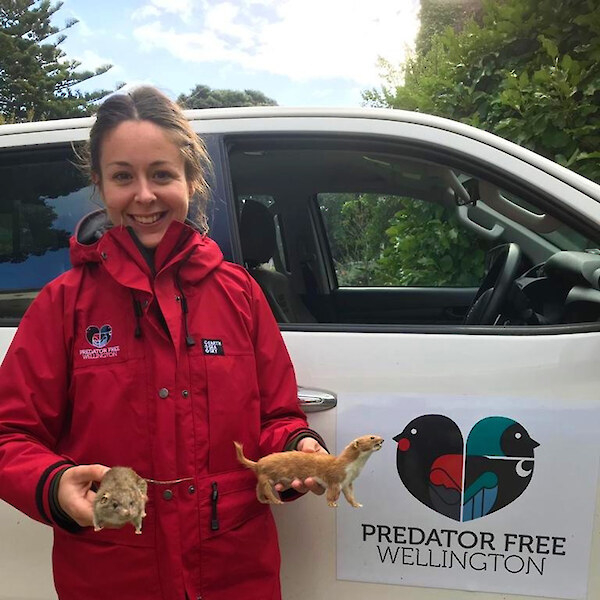Battle stations
This article was part of an eight-week guest column in The Post by our Board Chair and former Post editor Tim Pankhurst, published on 8 June 2024. See original article here.
Predator Free Wellington in partnership with The Post are covering all aspects of the battle against rats and stoats and weasels being fought across the city. Predator Free Wellington Eradication Technical Officer Emma Rowell with a stuffed weasel and ship rat.
Predator Free Wellington Eradication Technical Officer Emma Rowell with a stuffed weasel and ship rat.
And Wellingtonians are embracing the operation, with a 97% approval rating, according to Wellington City Council’s biennial social research survey. We’ll put the remaining 3% down to a statistical error.
No other capital city, or any major city, is achieving what is happening here – an increase in biodiversity rather than the sad decline and extinctions that have become the norm across the globe.
The tūī and kākā chortling from the trees are telling a good news story that will keep on giving.
And we sure do need a lift in a wonderful city and region that has lost a little of its shine, and the coolness relates more to the weather.
With Miramar Peninsula won and now Kilbirnie, Rongotai and Lyall Bay cleared, the battle front has moved westward to the central city and Hataitai and Evans Bay. But it is also vital to remain vigilant over the large territory that has been liberated.
Research and experience tells us that animal behaviour can change quite rapidly. When we get down to chasing individual animals, we find they may not occupy a traditional home range, but rather travel widely looking for a mate.
This was the case with Stumpy the rat, uniquely identified by the lack of a tail. Stumpy was picked up on a number of cameras over hundreds of metres in a relatively short time. We can spend a lot of time chasing shadows, potentially wasting precious labour resources.
We respond in the immediate area if a rat shows up on camera, but the animal may have already moved far away.
That is why it is so important to respond immediately, using tracker dogs and other tools such as detex (a non-toxic block that acts as a tracking trail, showing rat faeces and urine under ultraviolet light).
Any reports received are combed through by our technical team and a response on the ground initiated within 12 hours, or in many cases straight away in a military-style operation.
Getting to zero is just a start. Being able to maintain that state by quickly identifying any intruders and effecting an appropriate response is all part of the new normal on Miramar Peninsula, and in time, across the whole city.
The current detection network comprises 504 trail cameras triggered by movement, which are paired with automatic lure dispensers. These are regularly reviewed by PFW staff and volunteers. They have been delighted to see some welcome visitors such as kororā/little blue penguins and the rare kākāriki/red-crowned parakeet.
This network is far more comprehensive and sensitive than anywhere else in the world as far as we are aware, complementing Zealandia and Capital Kiwi’s unique conservation, and providing a major boost to the Aotearoa-wide Predator Free 2050 vision launched by former prime minister Sir John Key.
It also depends on public input through a variety of channels – an 0800 NORATS number, an online form to report suspicious activity, and on social media.
In a recent example, a resident alerted us to suspicious noises in her ceiling. The team responded by installing both a trap and a camera in the ceiling space. Video footage confirmed that a Norway rat had indeed taken up residence. It was soon caught and killed in the newly installed trap.
This was the first record of a Norway rat on Miramar Peninsula in 18 months.
Technical teams can overlay historic data, look into available habitat and analyse any images to determine risk.
Every animal captured is dissected to ascertain species, sex, age and ability to breed, to help build a risk profile. A juvenile rat means recent breeding, and we may be looking for multiple rats from the same litter.
A female rat captured with recent wear on her nipples may indicate recent feeding of baby animals, meaning a higher likelihood of multiple animals in a location that requires more lethal devices and a higher level of attention.
Research partner Manaaki Whenua/Landcare Research, based at Lincoln, is building a genomic profile analysing DNA from rat tail snips, plus measuring livers for toxicity. This will help to identify any re-invaders from other parts of the city and beyond, to determine pathways and shut them down at the source.
As for that elusive stoat intruder that has been much publicised, he has not been seen on Miramar Peninsula for nearly a month and is presumed departed, either permanently via poison or destined to be caught elsewhere.
Posted: 8 June 2024
